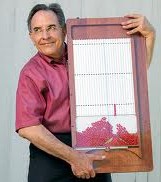- unknown (b.)
Bio/Description
After earning his Ph.D. in applied math at the University of Akron, he worked on robotic assembly lines in Scotland. In the 1970s, he paired up with Ferrari?s Formula 1 team and helped pioneer the use of computer chips in race cars. His algorithms calculated the position of the wheels relative to the road and adjusted the suspension up to 60 times a second, letting the racers go faster by hugging curves tighter. He was a consultant for Pinewood Studios in England when Christopher Reeve arrived to film the first Superman in 1978. To give the actor the appearance of flight in the pre-computer graphics era, he wrote computer models that precisely adjusted Reeve?s position while he was strapped into a full-body rig 30 feet off the ground. He joined Intel (INTC), the largest chip company that still designs and manufactures its own products as its in-house mathematician. He realized that trying to improve predictive models was no use and that forecasting is the hardest problem in math. Semiconductor plants cost about $5 billion each, and some of the equipment has to be ordered three years in advance. Guessing wrong about future demand is very expensive: Being overly optimistic can lead to hundreds of millions of dollars in idle machinery, while underestimating means billions in lost revenue. So he started writing equations. He designed a financial contract giving Intel the option to buy a specific piece of machinery at a specific time. The company pays its suppliers a modest amount of money upfront for the contract. If it ends up not needing the machine, the chipmaker loses the money or the supplier can find another buyer. But the contract ensures Intel has access to the equipment it needs when it?s needed. Options contracts are nothing new?they?re used to buy and sell oil, wheat, and other commodities all the time?but high-tech chipmaking equipment is not a liquid market, so there?s no easy way to figure out a fair price for the contracts. He partnered with fellow mathematicians at Stanford University to build a computer model of an Intel production line. It simulated 142 different pieces of equipment; by varying the prices and delivery times for each machine and factoring in how much delays would cost, Intel and its suppliers figured out fair contract prices. He stated the resulting options have saved Intel an estimated $125 million since 2008, when the program began in earnest. He stated, ?Getting the most out of Intel?s $12.5 billion annual plant and equipment budget is just the latest way of applying advanced mathematics to unusual problems.? He says his varied career shows that knowing advanced math can help improve just about any product or process. ?That?s true whether it?s a Formula 1 car or a movie special effect, a space station or an Intel factory,? he says. In ?Turing?s Cathedral? by George Dyson it is noted that he is the writer of ? Electronic Computers within the Ordnance Corps?, History Office, Aberdeen Proving Ground, MD., November 1961.
-
Gender:
Male -
Noted For:
Headed up group of fellow mathematicians at Stanford University which calculated fair contract prices allowing the company to minimize their obligation and maximize the available equipment supply by designing a financial contract giving Intel the option to buy a specific piece of machinery at a specific time – He also helped to pioneer the use of computer chips in race cars -
Category of Achievement:
-
More Info:


